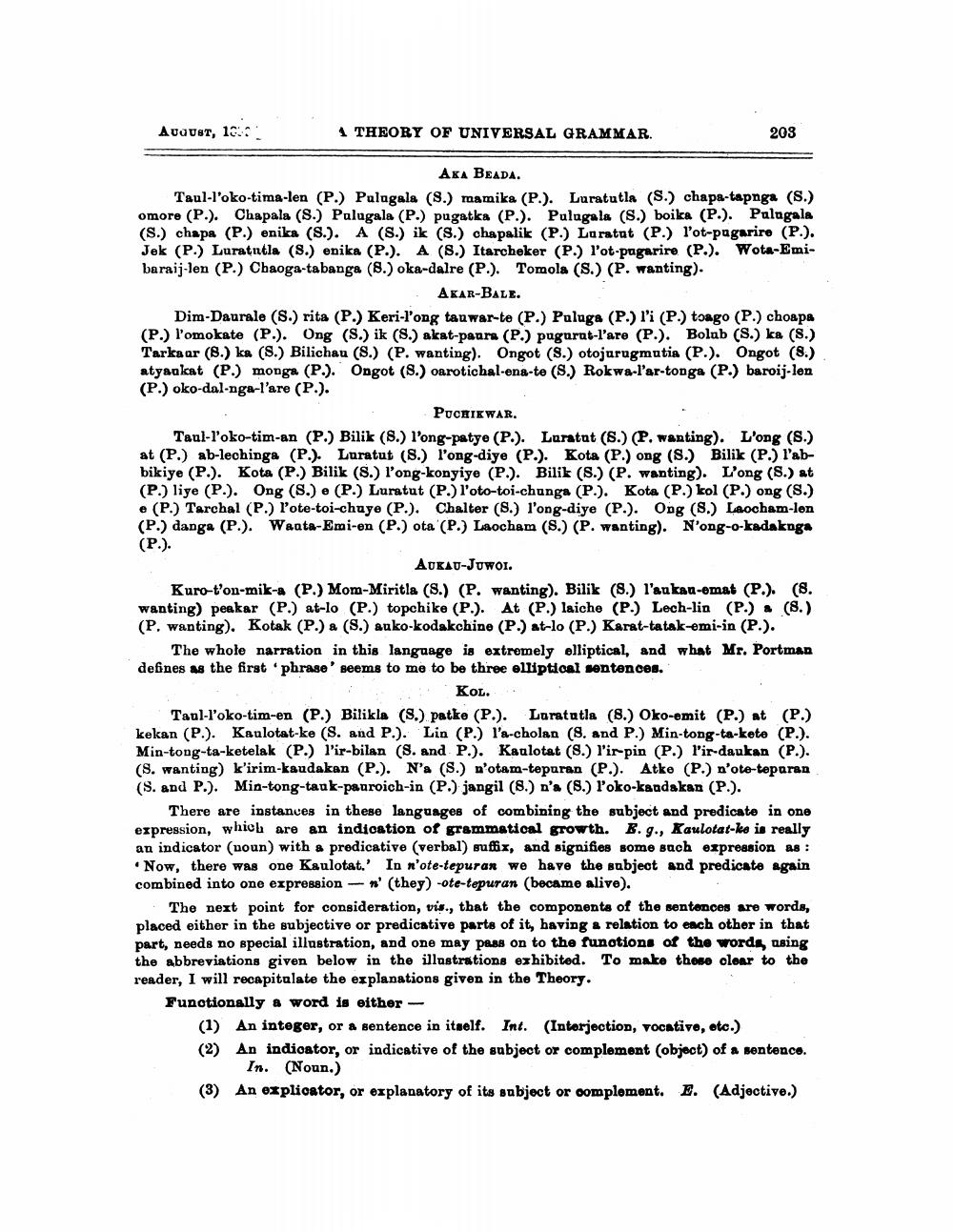________________
August, 10:
1 THEORY OF UNIVERSAL GRAMMAR.
203
AKA BEADA. Taul-l'oko-tima-len (P.) Palagala (8.) mamika (P.). Luratutla (S.) chapa-tapnga (S.) omore (P.). Chapala (8.) Palugala (P.) pugatka (P.). Palagala (S.) boika (P.). Palagala (S.) chapa (P.) enika (S.). A (S.) ik (S.) chapalik (P.) Laratat (P.) l'ot-pagarire (P.). Jek (P.) Luratntla (S.) enika (P.). A (8.) Itarcheker (P.) l'ot-pagarire (P.). Wota-Emibaraij-len (P.) Chaoga-tabanga (8.) oka-dalre (P.). Tomola (S.) (P. wanting).
A KAR-BALE. Dim-Daurale (S.) rita (P.) Keri-l'ong tauwar-te (P.) Puluga (P.) l'i (P.) toago (P.) choapa (P.) l'omokate (P.). Ong (S.) ik (8.) akat-paara (P.) pugurat-l'are (P.). Bolab (S.) ka (8.) Tarka ar (8.) ka (S.) Bilichau (S.) (P. wanting). Ongot (S.) otojurugmutia (P.). Ongot (8.) atyaukat (P.) monga (P.). Ongot (8.) oarotichal-ena-te (8.) Rokwa-l'ar-tonga (P.) baroij-len (P.) oko-dal-nga-l'are (P.).
PUCHIKWAR. Taul-l'oko-tim-an (P.) Bilik (8.) l'ong-patye (P.). Laratut (S.) (P. wanting). L'ong (S.) at (P.) ab-lechinga (P.). Luratut (S.) l'ong-diye (P.). Kota (P.) ong (S.) Bilik (P.) l'abbikiye (P.). Kota (P.) Bilik (8.) l'ong-konyiye (P.). Bilik (S.) (P. wanting). L'ong (S.) at (P.) liye (P.). Ong (S.) e (P.) Laratut (P.) l'oto-toi-chunga (P.). Kota (P.) kol (P.) ong (S.)
(P.) Tarchal (P.) l'ote-toi-chuye (P.). Chalter (S.) l'ong-diye (P.). Ong (S.) Laocham-lon (P.) danga (P.). Waata-Emi-en (P.) ota (P.) Laocham (S.) (P. wanting). N'ong-o-kadaknga (P.).
AUKAU-JUWOI. Kuro-t'on-mik-a (P.) Mom-Miritla (S.) (P. wanting), Bilik (8.) l'aukan-emat (P.). (8. wanting) peakar (P.) at-lo (P.) topchike (P.). At (P.) laiche (P.) Lech-lin (P.) . (8.) (P, wanting). Kotak (P.) a (S.) auko-kodakchine (P.) at-lo (P.) Karat-tatak-emi-in (P.).
The whole narration in this language is extremely elliptical, and what Mr. Portman defines as the first phrase seems to me to be three elliptical sentences.
KOL.. Taul-l'oko-tim-en (P.) Bilikla (8.) patke (P.). Luratatla (8.) Oko-emit (P.) at (P.) kekan (P.). Kaulotat-ke (S. and P.). Lin (P.) l'a-cholan (8. and P.) Min-tong-ta-kete (P.). Min-tong-ta-ketelak (P.) l'ir-bilan (S. and P.). Kaulotat (8.) l'ir-pin (P.) l'ir-daukan (P.). (S. wanting) k'irim-kaudakan (P.). N'a (S.) n'otam-tepuran (P.). Atke (P.) n'ote-teparan (S. and P.). Min-tong-tauk-pauroich-in (P.) jangil (8.) n'a (8.) l'oko-kandakan (P.).
There are instances in these languages of combining the subject and predicate in one expression, which are an indication of grammatical growth. E. g., Kaulotat-ke is really an indicator (noun) with a predicative (verbal) suffix, and signifies some such expression as :
Now, there was one Keulotat.' In n'ote-tepuran we have the subject and predicate again combined into one expression - " (they) -ote-tepuran (became alive).
. The next point for consideration, vis., that the components of the sentences are words, placed either in the subjective or predicative parts of it, having a relation to each other in that part, needs no special illustration, and one may pass on to the functions of the words, asing the abbreviations given below in the illustrations exhibited. To make these clear to the reader, I will recapitulate the explanations given in the Theory. Funotionally a word is either -
(1) An integer, or a sentence in itself. Int. (Intorjection, vocative, etc.) (2) An indicator, or indicative of the subject or complement (object) of a sentence.
In. (Noun) (3) An explicator, or explanatory of its subject or complement. E. (Adjective.)




